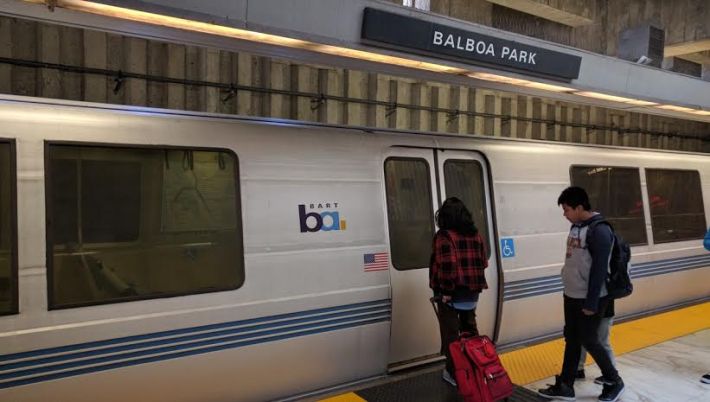
While the rest of the Bay Area was heading to the beach this Labor Day weekend, BART was working around the clock between Glen Park and Daly City, repairing tracks and switches. This was the fourth weekend closure necessary for the work. As before, bus bridges were provided between Daly City, Balboa Park and Glen Park stations.
From the BART release on the closures:
We have to close the tracks between Glen Park and Daly City stations on multiple weekends between the end of July and October including Labor Day weekend. We will be making vital repairs to our tracks including adding sound dampening equipment to the curved trackway in order to reduce noise from the trains. Crews will work 24 hours a day during the shutdown. Other work will include improvements to Balboa Park Station and tree trimming along the trackway.
So how are things going? "The work is on schedule if not ahead of schedule. We may be able to drop the last weekend (Oct. 15-16) but are keeping it on the schedule as now for tentative, just in case," explained Alicia Trost, a spokeswoman for BART, in an email to Streetsblog. "The other two weekends (9/17-18 and 10/1-2) are still planned."
One can hear BART trains passing from miles away, as wheels cause the rails to resonate. It can be positively deafening inside the trains or close to the line. The above video is from BART and it explains what causes the noise--and what the agency is doing to quiet things down as part of this work.
But rails and tracks are only part of the problem. The train cars and their wheels are also to blame. Streetsblog has written previously about how BART's new cars have a more traditional, conical wheel profile--so that each passing train will cause less wear to the rails. This is critical on turns--such as the turn between Glen Park and Daly City--as the outside wheels have to travel slightly farther. The great physicist and teacher Richard Feynman explained what that's all about in one of his short lectures/chats. To keep it simple, BART, for historical reasons, has a flat edge on its wheels, which deforms and wears out the rail surface faster than a traditional train wheel--and is the underlying reason behind BART's peculiar howl.
Henry Kolesar, Chief Vehicle Engineer at BART’s Hayward repair facility, explained during a previous interview with Streetsblog that they were also studying ways to taper the profile of the wheels on BART's current fleet so they cause less wear. But before doing it, BART engineers wanted to be certain cutting a taper into the wheels on the current fleet won't cause unforeseen problems, so they did mathematical models and ran tests for a couple of years. They will now start cutting the wheels into a more traditional profile as they do regular maintenance. It'll take about three years to redo all the wheels on all the cars. "All the data showed that the new wheel profile would not only be quieter, it would be as safe if not even safer than the current cylindrical wheel profile," BART wrote in its release on the project.
As Streetsblog readers will also recall, the BART board is placing a $3.5 billion bond on the November ballot for even more repairs. "The bond will allow us to make the types of investments we're making at Daly City throughout our entire system," explained Nicholas Josefowitz, who represents San Francisco's district 8 on the BART Board of Directors. "BART has reoriented itself as an organization to focus first and foremost on reinvestment in and modernizing of our existing system. We need to do this to keep BART safe and reliable, and to increase the capacity on our core system to keep up with regional growth and continue to provide congestion relief on the highways."
Meanwhile, BART's flashy new train cars and efforts at noise reduction are getting the most attention in the press because they're easy to see and hear. But the replacement of the switches and turnouts between Balboa Park and Daly City is arguably even more essential to, literally, keeping BART trains on the tracks. So for hard-core transit geeks, Streetsblog has embedded a video at the bottom of this article that explains that aspect a bit more too. "Less than five percent of track miles are made of switches, but over 17 percent of the maintenance budget is spent on them," explains the announcer in the film. And that's one area where BART is just like any other railroad.
"The switch work is integrated into the other work being done. As they pulled old rail, they pulled all the old switching equipment as well, and as they install new rail, they are also hooking up the new switching equipment as well as other computer equipment, electrical equipment, etc.," explained Trost. "The next two weekends [they] will be [installing] ribbon rail (long sections of rail), switch rails, safety rails, crossover rail, and more switch machines and then do testing in order to return the crossover to service. The result will be more reliability, quieter rails, and more flexibility when there are issues because they will have a working crossover they can use."




